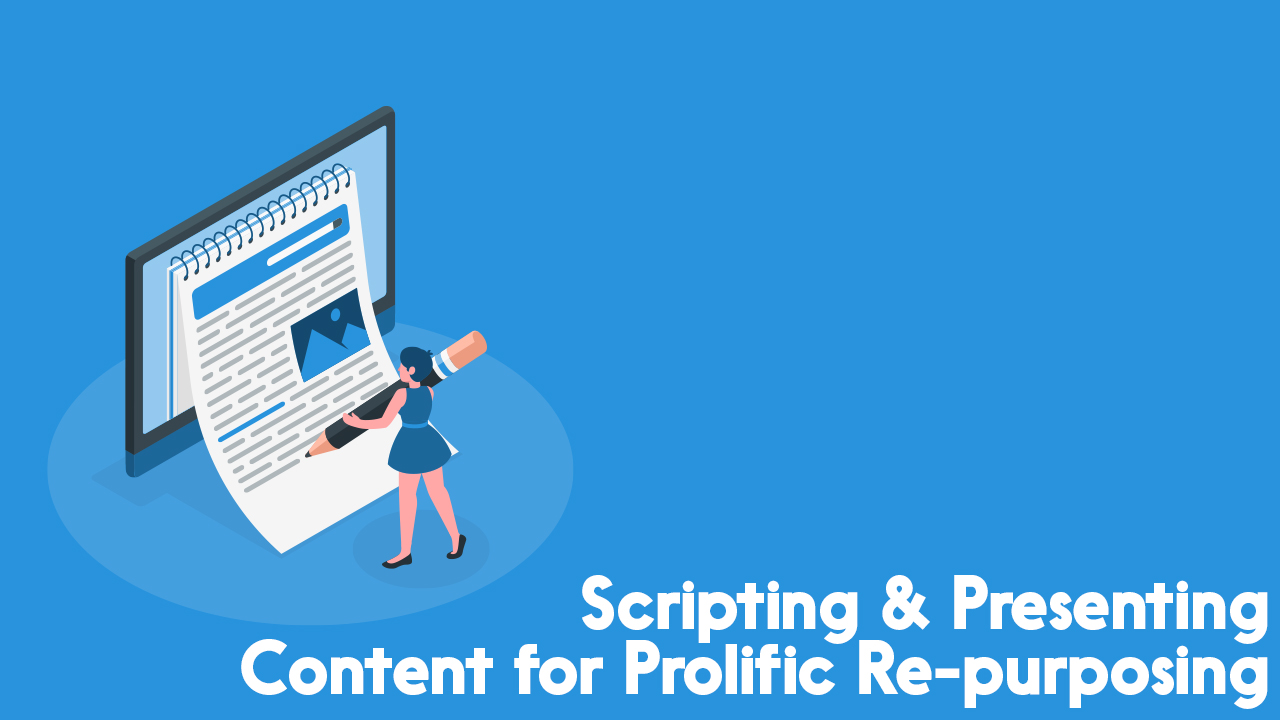Scripting & Presenting for Prolific Re-Purposing: Content Planning Guide

So it’s time to think about content planning!
I started this series with the promise of prolific content. I know that’s a big promise, but I also know I can get you there. Or, at least, I can show you a way to make it possible.

Content Stacking
This is Chapter 4 of our Content Stacking series. Find the introduction here.
Then it’s your job to deliver. That’s what the next 2 chapters are all about – Design. Delivery. Creation.
In this first part, I’m going to show you how to present your one piece of content in a way that sets it up for spectacular, smart, re-purposing. That leads, then, to being able to publish it in varied and prolific ways.
Remember, this isn’t about spamming that one thing all around the internet. We’re talking SMART re-purposing, rather than the dumb kind you see elsewhere. It involves a combination of structure and medium to create media blocks that build your stack of content.
First, we’ll do scripting, then we’ll do delivery. Once we’re done, you’ll know the principles and be able to adapt it to your own style. Part two will then show you how to record the spectacular results.
Here’s where the prolific content really starts. Let’s have a look.
Content Planning: Recapping The Structure
In the last chapter, we dug right into structure, and all of the benefits that come with it. Remember, a bit of structure makes content more easy and productive for you, and more useful and interesting for your listeners. But, there’s one other thing is does too – it enables fantastic levels of re-purposing.
The structure was like so:
1. Topic Overview > 2. Theory > 3. Context > 4. Action.
Our aim in this chapter is figuring out how to create our content in a way that makes it as re-usable as possible. The structure is the heart and soul of that, whether you stick with this exact one, or create your own.
How to Script Your Recording
Since we’re talking about delivery, we can’t miss out scripting. This won’t take long, but it’s worth covering.
It’s worth it because, when you’re aiming for maximum re-use, the highest level of utility you can get from any one bit of content, you need to be tighter with your recording.
You might be used to doing things on-the-fly, in the past. “Winging it” is a legit (and common!) approach to podcasting, in particular. The results can be great – natural, ad-libbed conversations are often the most engaging things you can find.
But… they can also be horrendous. The lack of plan is a risk. Risk of boredom, risk of irrelevance, risk of annoyance. Content stacking is all about creating fanatical fans, and to do that, we can’t afford that possibility, even once in a while.
Don’t worry, though. Even a few minutes spent on a plan reduces your chances of pissing off your listeners by a factor of 10.
On top of which, that plan is what leads to re-purposing nirvana. By sticking to a plan, and doing it every time, you can start to extract a tonne – a TONNE – of value, from every recording, and every bit of writing.
So, script it. Script the episode.
I don’t mean word for word. There are a range of ways to script and to be prolific, you need to keep it simple.

What Does a Script Look Like?
For me, a script is a reasonably detailed bullet-point plan. Funnily enough, we’ve already done that! Remember in the content planning stages, we fleshed our idea out into a series plan? Once I created the episode titles, I put a bit of meat on the bones of each episode itself.
I’ll tend to have anything from 3 to 10 mains points to cover in an episode – so that’s 3 to 10 bullet points. Then, each point will have – sometimes, not always – a few bits of detail underneath. In the end, I have a bullet-point list with, say, 6 top-level bullets, each with a few bits of detail underneath.
Importantly, those 6 points will be split into the 4 segments of my structure. The first bullet will always be my overview, with a few detailed bullets underneath to cover the summary points. Then, the theory might cover a few top-level bullets, and detail underneath. Next, we have the context, perhaps only 1, or perhaps a few bullets, outlining stories and examples I want to introduce. Then, finally, the actions> This will comprise just 1 or 2 bullets, with a little detail about what I want people to do.
That’s a plan – it takes 5 minutes to create, and it keeps us right on track.
At this point, I always get the shout, “What?! That’s working for the man, robotic, totally ruining my personality, stunting my creativity!”
Well, grow up and get over it – this is how you get results. Without it, you’re 10 times as likely to suck. But with it, you’re 10 times MORE likely to give your audience exactly what they want, making them as happy as a pig in… well, his sty.
Think Like a Radio Presenter: Content Planning
Now that we have our content plan, the next part of the formula is in how you present it. Specifically, it’s about how you transition between the sections, the segments, of your show.
Taking that structure we recapped above, we’re looking to think like a radio presenter in how we transition between each one.
Radio presenters have to assume that people are dropping in and out every minute of their show. A listener may have just tuned in halfway through a segment, or they may have been tuned in physically, but tuned out mentally. Radio is background, after all.
To get around that, they cut things up into smaller segments, and they keep people well informed about what’s just happened and what’s coming next.
We can use this ’transition mentality’ in our structure to help with smart re-purposing.
The idea is this:
“Every time you transition from one segment to the next: summarise it, close it out, then introduce the next as if it’s a brand new show.”
An Example of a Radio Transition
Here’s how it might work as I come to the end of a Theory section in Podcraft, and move into the case study:
“…. and so dynamic mics show a little less range than condenser microphones for that reason. So, that ties up my coverage of the difference between dynamic and condenser microphones. I hope that’s made you more confident in choosing between the two varieties. Remember, my rule of thumb is – if you’re recording in an untreated or noisy environment, OR you’re recording on the move a lot, then get a dynamic mic. If you’re in a nice, quiet studio and can benefit from the more rich sound they offer, then get a condenser. Now, in the next section we’re going to cover my own case study which will show you the mics I’ve gone through over the years, and when and why I chose them.
I always think it’s useful to see how people are putting this stuff into action, so I want to show you my own path through the world of dynamic and condenser mics. We covered the theory in the last section, so you know the details, but now I’ll take you through my decisions, maybe put it in a bit of context for you. I hope that’ll help you figure out when to go for a condenser and when to go for a dynamic. So, it started, really, when I was working at a university and I was asked to record a podcast for the department….”
You can see what I’ve done here. I’ve come to the end of a section and I’ve tied it up. That means doing a little summary, a conclusion, and a “what’s next.” Then, when starting the next section, I make a point of introducing it, telling the listener what’s coming, and then reiterating what’s come before.
Guidance, Confidence & Repurpose
This is good for a few reasons. First, when a fan is listening right through, it helps with their learning. They’re getting regular recaps and guidance, both of which increase confidence and comprehension.
Next, it helps reduce confusion. Let’s face it, people are listening in the background sometimes. They’re driving, have to make a turn, and so, your signposting & your guidance, helps them stay on track when they’ve had to tune out for a minute.
Most importantly, though, this turns your podcast into a series of self-contained episodes. By giving each section its own intro and conclusion, you can start to chop them up, and release them individually.
This is what allows us to smartly re-purpose a podcast into a series of videos, and to really benefit from the strengths of each medium.

Playing to the Strengths of Audio & Video
Remember what we talked about in the first chapter – the attention difference between audio and video?
Well, if we’re going to reuse our one recording on both mediums we need to make sure it suits both.
That’s why this method works. By making each section of your recording self-contained, you can release:
- 1 podcast of 20+ minutes – a length that suits that medium
- 4 – 6 videos of 4+ minutes – a length that suits that medium
I say 4 to 6 videos because it’s often the case that you’ll want to cut the theory section up into more than 1 segment. It’s usually the longest, and it’s often suited to 2 or 3 sub-sections.
For instance, my example above might work well as a ‘Condenser mic’ video AND a ‘dynamic mic’ video.
The important thing to remember is that this is a principle, not a rule. You need to adapt this idea to your own context. I’ve already mentioned that about the structure – it’ll work great, “as is”, for some. But many will have to re-purpose (pun intended…groan…) the structure to work with your own content.
That might mean an intro, three different types of theory sections, a story and an action. That’s perfect: you can have 6 x 5min videos, which repurpose to one 30 minute podcast episode. Ideal.
Whatever structure you go with, try it, evolve it, refine it. Make it your own, and your listeners will love it as much as you do.
Content Planning: Next Steps
At this stage, we’re all ready to go. We have a plan and we know how to deliver it.
By now though, you might be thinking “Alright, I’ve got my content idea – where do I start?” Is it media first, or text?”
Head on over to the next chapter to find out…
Guide Index
- How Does Podcasting, Blogging & Video Work Together? #1
- Finding Content Ideas & Getting the Most From Every One #2
- A Podcast Structure for the Most Effective Teaching Possible #3
- Scripting & Presenting for Prolific Re-purposing: Content Planning Guide #4
- The 3-Step Content Editing Process to Create Spectacular Clarity #5
- How to Write a Blog for Prolific Repurposing #6
- Recording Audio & Video for Prolific Repurposing #7
- Blog Posts that Grow Podcast Listeners & Video Viewers #8
- YouTube Videos that Drive Action & Promote Your Podcast #9
- How to Drive Action From a Podcast #10
